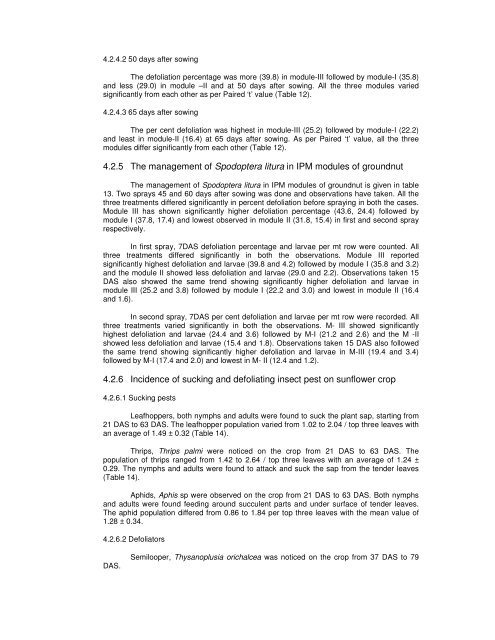screening elite genotypes and ipm of defoliators in groundnut
screening elite genotypes and ipm of defoliators in groundnut
screening elite genotypes and ipm of defoliators in groundnut
You also want an ePaper? Increase the reach of your titles
YUMPU automatically turns print PDFs into web optimized ePapers that Google loves.
4.2.4.2 50 days after sow<strong>in</strong>g<br />
The defoliation percentage was more (39.8) <strong>in</strong> module-III followed by module-I (35.8)<br />
<strong>and</strong> less (29.0) <strong>in</strong> module –II <strong>and</strong> at 50 days after sow<strong>in</strong>g. All the three modules varied<br />
significantly from each other as per Paired ‘t’ value (Table 12).<br />
4.2.4.3 65 days after sow<strong>in</strong>g<br />
The per cent defoliation was highest <strong>in</strong> module-III (25.2) followed by module-I (22.2)<br />
<strong>and</strong> least <strong>in</strong> module-II (16.4) at 65 days after sow<strong>in</strong>g. As per Paired ‘t’ value, all the three<br />
modules differ significantly from each other (Table 12).<br />
4.2.5 The management <strong>of</strong> Spodoptera litura <strong>in</strong> IPM modules <strong>of</strong> <strong>groundnut</strong><br />
The management <strong>of</strong> Spodoptera litura <strong>in</strong> IPM modules <strong>of</strong> <strong>groundnut</strong> is given <strong>in</strong> table<br />
13. Two sprays 45 <strong>and</strong> 60 days after sow<strong>in</strong>g was done <strong>and</strong> observations have taken. All the<br />
three treatments differed significantly <strong>in</strong> percent defoliation before spray<strong>in</strong>g <strong>in</strong> both the cases.<br />
Module III has shown significantly higher defoliation percentage (43.6, 24.4) followed by<br />
module I (37.8, 17.4) <strong>and</strong> lowest observed <strong>in</strong> module II (31.8, 15.4) <strong>in</strong> first <strong>and</strong> second spray<br />
respectively.<br />
In first spray, 7DAS defoliation percentage <strong>and</strong> larvae per mt row were counted. All<br />
three treatments differed significantly <strong>in</strong> both the observations. Module III reported<br />
significantly highest defoliation <strong>and</strong> larvae (39.8 <strong>and</strong> 4.2) followed by module I (35.8 <strong>and</strong> 3.2)<br />
<strong>and</strong> the module II showed less defoliation <strong>and</strong> larvae (29.0 <strong>and</strong> 2.2). Observations taken 15<br />
DAS also showed the same trend show<strong>in</strong>g significantly higher defoliation <strong>and</strong> larvae <strong>in</strong><br />
module III (25.2 <strong>and</strong> 3.8) followed by module I (22.2 <strong>and</strong> 3.0) <strong>and</strong> lowest <strong>in</strong> module II (16.4<br />
<strong>and</strong> 1.6).<br />
In second spray, 7DAS per cent defoliation <strong>and</strong> larvae per mt row were recorded. All<br />
three treatments varied significantly <strong>in</strong> both the observations. M- III showed significantly<br />
highest defoliation <strong>and</strong> larvae (24.4 <strong>and</strong> 3.6) followed by M-I (21.2 <strong>and</strong> 2.6) <strong>and</strong> the M -II<br />
showed less defoliation <strong>and</strong> larvae (15.4 <strong>and</strong> 1.8). Observations taken 15 DAS also followed<br />
the same trend show<strong>in</strong>g significantly higher defoliation <strong>and</strong> larvae <strong>in</strong> M-III (19.4 <strong>and</strong> 3.4)<br />
followed by M-I (17.4 <strong>and</strong> 2.0) <strong>and</strong> lowest <strong>in</strong> M- II (12.4 <strong>and</strong> 1.2).<br />
4.2.6 Incidence <strong>of</strong> suck<strong>in</strong>g <strong>and</strong> defoliat<strong>in</strong>g <strong>in</strong>sect pest on sunflower crop<br />
4.2.6.1 Suck<strong>in</strong>g pests<br />
Leafhoppers, both nymphs <strong>and</strong> adults were found to suck the plant sap, start<strong>in</strong>g from<br />
21 DAS to 63 DAS. The leafhopper population varied from 1.02 to 2.04 / top three leaves with<br />
an average <strong>of</strong> 1.49 ± 0.32 (Table 14).<br />
Thrips, Thrips palmi were noticed on the crop from 21 DAS to 63 DAS. The<br />
population <strong>of</strong> thrips ranged from 1.42 to 2.64 / top three leaves with an average <strong>of</strong> 1.24 ±<br />
0.29. The nymphs <strong>and</strong> adults were found to attack <strong>and</strong> suck the sap from the tender leaves<br />
(Table 14).<br />
Aphids, Aphis sp were observed on the crop from 21 DAS to 63 DAS. Both nymphs<br />
<strong>and</strong> adults were found feed<strong>in</strong>g around succulent parts <strong>and</strong> under surface <strong>of</strong> tender leaves.<br />
The aphid population differed from 0.86 to 1.84 per top three leaves with the mean value <strong>of</strong><br />
1.28 ± 0.34.<br />
4.2.6.2 Defoliators<br />
DAS.<br />
Semilooper, Thysanoplusia orichalcea was noticed on the crop from 37 DAS to 79
















